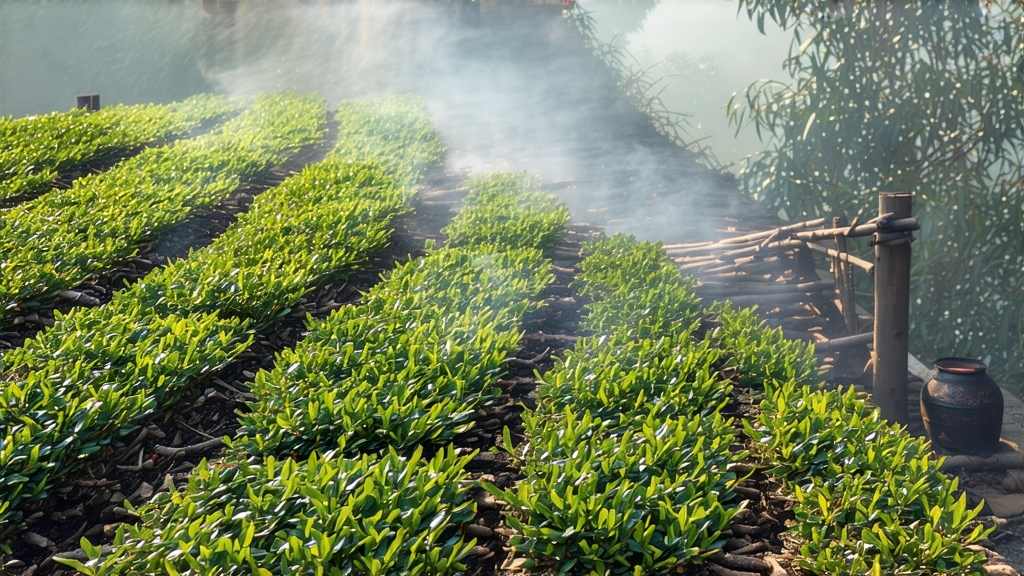
When European tea caravans first reached the bustling docks of Amsterdam in 1604, the fragrant chests they unloaded were labeled “Bohea” – a corruption of the Min-nan words for “Wuyi.” Inside those lead-lined crates lay slender, coal-black twists that, once infused, bled a deep crimson liquor and exhaled an aroma utterly alien to the herb gardens of Europe: pine smoke, longan fruit, and the scent of wet slate after a summer storm. That tea was Lapsang Souchong, the earliest black tea ever created and the prototype that would inspire Assam, Ceylon, and Keemun. Four centuries later it remains China’s most polarizing leaf—revered by whisky blenders, adored by perfumers, yet misunderstood by drinkers who know it only as an assertive “smoked tea.” This essay invites the global tea traveler to look beyond the campfire note and discover the layered history, micro-terroir, and delicate craftsmanship that make authentic Lapsang Souchong a living fossil of the tea world.
Origin Myth and Documented History
Tongmu Guan, a narrow granite gorge tucked inside the Wuyi Mountains of Fujian, is the officially protected birthplace of Lapsang Souchong. At 1,200 m elevation the gorge traps cool, humid air that condenses into perpetual mist; pine and cedar cling to cliffs, their resin perfuming the breeze. Local legend attributes the birth of black oxidation to a Qing-dynasty army bivouac that delayed the spring harvest. Villagers, facing spoiled leaves, dried them over fresh pine fires to mask the mustiness, inadvertently discovering that heat fixed a crimson color and unlocked malt sweetness. Archival customs records from the port of Xiamen show that by 1640 “smoked xiaozhong” (small-leaf variety) was already trading at twice the price of green Wuyi rock teas, suggesting a deliberate rather than accidental process. British East India Company logs from 1676 list “Lapsang” as a separate tariff line, proof that the tea had become a branded commodity before Congou or Keemun even existed.
Terroir: Why Tongmu Cannot Be Cloned
In 2002 the Chinese government demarcated 670 hectares of Wuyi’s core scenic zone as “Original Terroir Lapsang Souchong.” Soils are weathered tuffaceous sandstone rich in potassium and manganese; day-night temperature swings average 10 °C, slowing leaf growth and concentrating amino acids. Most crucial is the gorge’s endemic pine species, Masson’s pine (Pinus massoniana), whose resin contains α-pinene and limonene that bind to tea polyphenols during smoking. Attempts to replicate the process in Yunnan or India yield a harsher, turpentine-like smoke because the same terpene profile is absent. Thus, every authentic leaf is still withered, oxidized, and smoked within a five-kilometer radius of Tongmu Guan’s stone-gated entrance.
Leaf Grades and Styles
Lapsang Souchong is not a monolith. The industry recognizes four grades determined by pluck standard and smoking protocol:
- Zhengshan Xiaozhong (unsmoked): Produced from the same Xiaoye (small-leaf) cultivar but dried in bamboo baskets over charcoal embers without pine smoke. The cup is burgundy, the aroma reminiscent of dried longan and honey.
- Traditional Lapsang Souchong: Picked as one bud plus two leaves, withered over pine fires, pan-fired, rolled, then smoked three separate times using fresh pinewood embers at 80 °C. The classic “campfire” tea.
- Organic Fruit-wood Lapsang: A modern adaptation that substitutes cherry or lychee wood for pine, yielding a softer, almost bacon-sweet smoke popular in the EU market.
- Special Needle Lapsang: The tippy spring pluck is twisted into glossy needles and smoked only once, creating a refined, wine-like liquor that commands auction prices above USD 1,000 per kilogram.
Craft: The 18-Hour Smoke-Oxidation Dance
Harvest begins at dawn on the Qingming festival when the first standard—one bud, two leaves—reaches 3 cm length. Leaves are spread 3 cm deep on bamboo trays suspended in the upper story of a three-level pine shed. A gentle fire of Masson’s logs smolders below; rising smoke dehydrates the